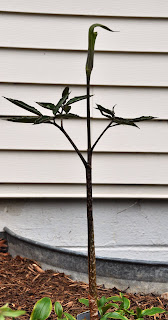Since I have been distracted in running another blog for the church this last month, I have some catching up to do. I will begin with the still small collection of Jack-in-the-Pulpits that I have. Only three varieties, though I could easily buy many more.
This is an Arisaema serratum, bought at a National Arboretum sale a few years ago. It is the earliest of the varieties to bloom, and shoots up to three feet tall before that pitcher-shaped bloom appears. This grows up so early, the toad lilies that will grow up later and hide its dying leaves have just stuck their first leaves out of the ground. The serratum leaves are very narrow and spiky, creating a slightly creepy effect that looks like something out of a vampire movie.
Unfortunately, as you can tell from the background of vinyl siding at the top and cinder block foundation at the bottom, it's setting is not the most attractive. But I can guarantee you that it is so exciting to see the growing spear point coming out of the ground announcing its arrival, that you don't really care. You saw this in the previous blog entry for the End of March. See, I did come through with the promised pictures.
The next ones to come up are some native Jack-in-the-Pulpits that I rescued several years ago from the side of the ravine. The ravine, which fairly regularly has had times when the soil gets wet and the sides slide down to the bottom, had exposed a clump of the arisaema. I did not want to wait to see if it would survive the location where it was newly exposed to full sunlight, so I dug out a small portion and moved it up alongside the house. That was my first time to deal with the plants, and I was surprised to discover they have a small bulb in the ground. This makes it fairly easy to move them around since there are not lots of long roots.
The native ones are plain in comparison with the more exotic varieties with a mostly green pitcher and short in stature. But as the native, they have a claim to space before all the rest, and usually have the largest clumps of bright red berries in the Fall.
Finally, here is the Arisaema sikokianum, a Japanese variety that the Plant Delights Nursery describes as "circumcised!" That is one sample of their humorous plant descriptions, which goes on to say about this variety "since Arisaema sikokianum doesn't offset or engage in sexual self-satisfaction, you'll need more than one to start a family." At the current prices, this one will have to tough it out on its own, so it has not had a display of red berry babies in the Fall. I don't know that I could handle the sight of a large clump of these.
But maybe I should end its celibate life and buy another? All of the baby plants could be sold at the church's May Fest. These would always be blooming at the time of the sale, and they could be sold at really great prices, spreading across the county! Every year I give the Episcopal Church Women some of my rapidly expanding clump of Acanthus plants, they sell out of them rapidly.
I suspect the native plant society is not happy with me.



No comments:
Post a Comment